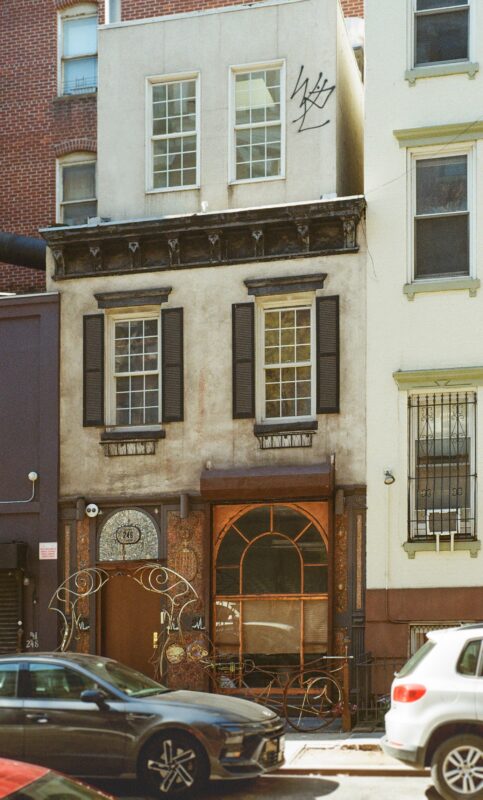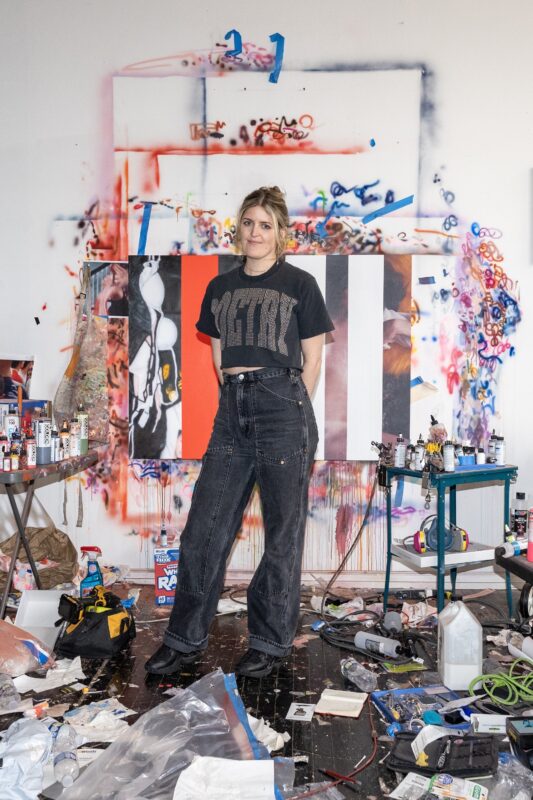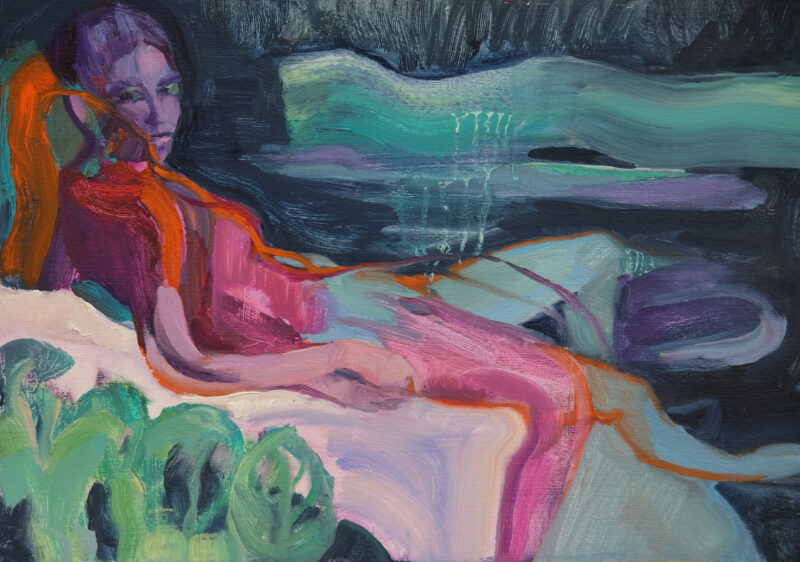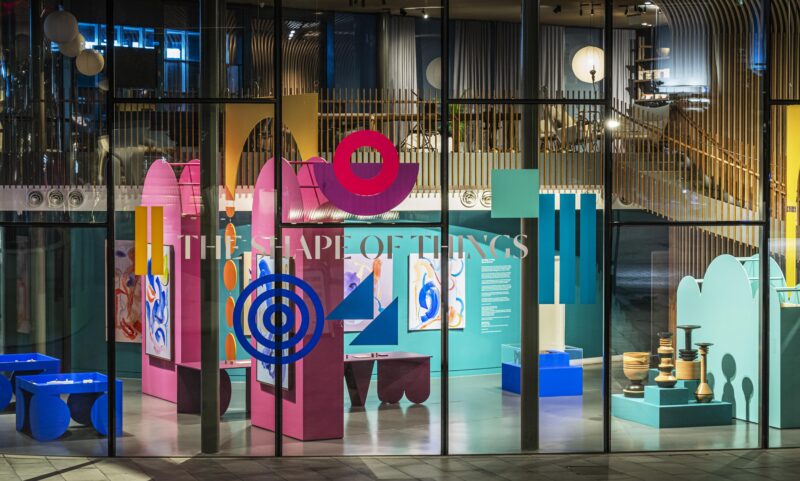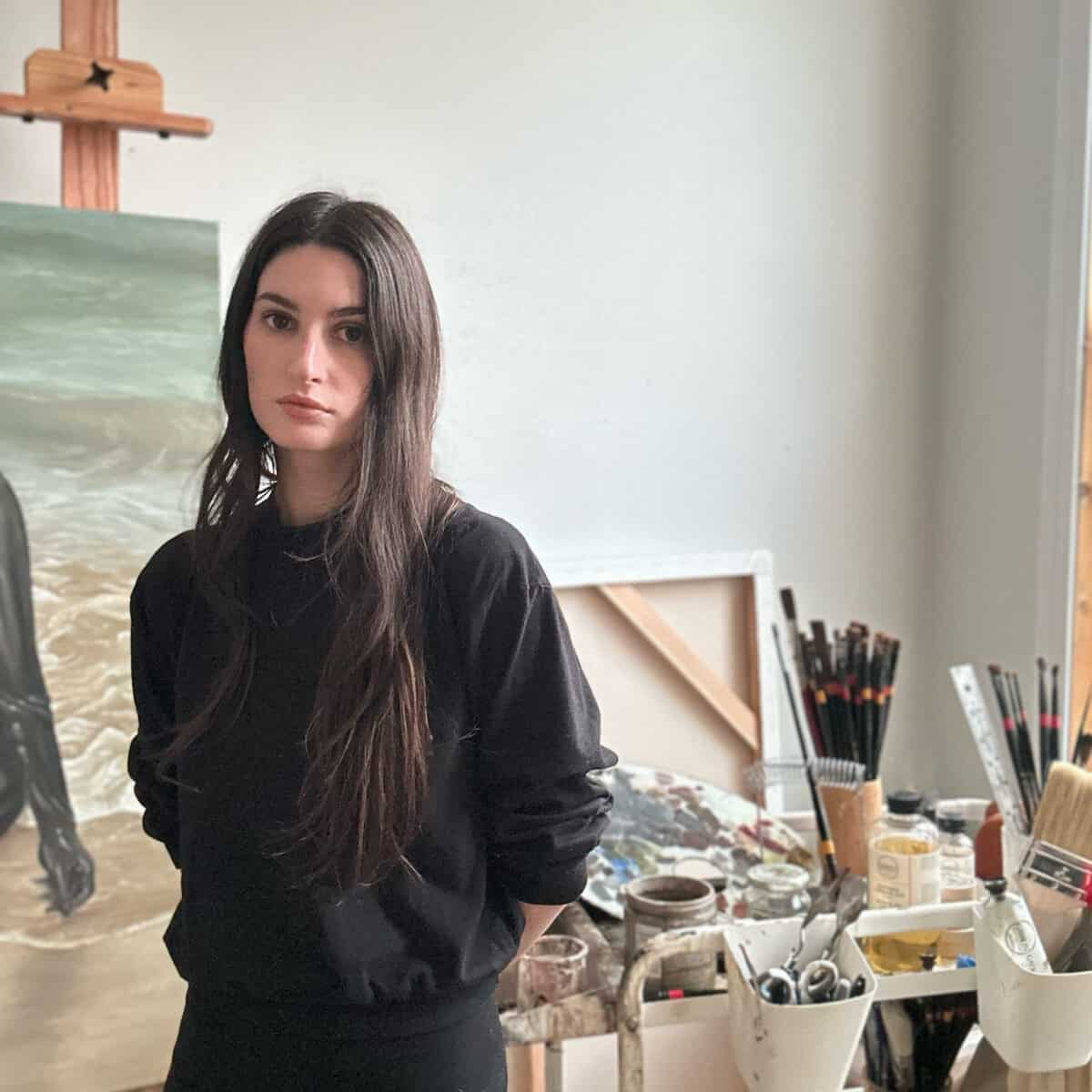
Noelia Towers is a visual artist who creates highly rendered oil paintings that allow her to express her exploration of self by sharing moments of pride and empowerment as well as vulnerability and uncertainty. Produced from a multitude of personal interests and histories, Towers bestows the public space with her archive of knowledge and experiences by using the canvas as a form of therapy.
Serving as her own model, Towers provides the viewer with a traditionally feminine image partnered with intimate exposure, suffering, along with dark and mysterious undertones. Originally from Barcelona, Towers lives and works in Chicago where she uses her past history and current interests to educate and entertain. The works are arresting and can be read quickly, but they all carry subsequent readings and meanings.
Towers’ second solo exhibition at de boer Gallery opens in Fall/Winter 2023.

Phillip Edward Spradley: Painting can require a lot of energy, physical and mental, and your ‘beginning’ is actually processed quickly with polaroid photography. Does capturing a moment with photography hold as much space and importance as the final painting or is it more of a tool utilized for an end result?
Noelia Towers: Actually the beginning is the most difficult part! I struggle a lot when it comes to taking photographs for reference or even during image sourcing. I find it incredibly tedious and time-consuming, and sometimes the concept in my head doesn’t translate very well into physical form. It’s hard to take self-portraits (I will often use my friend Lilly as a model since we have similar features) and make them look the way you imagined them in your mind. Once that part is done, the rest is easy since painting is my actual thing and what I am skillful at.
Sometimes the reference images I take don’t have to be perfect, but some other times I strongly rely on them, and if they aren’t good enough the end result might be deficient. It’s kind of a struggle, definitely my least favorite part of the process.
P.E.S: Your paintings are both largely autobiographical and self-portraiture, they are paintings of your relationships, but there are various subcultures and familiar domestic settings that allow outside accessibility. Are there universal truths and interests you think connect people to your work?
N.T: I don’t believe anyone’s personal experiences are unique to them. Maybe the way each person lives through said experiences is, but not the experience itself.
I love Carl Jung’s concept of the collective unconscious, the idea that there is a shared reservoir of archetypes and symbols that exist within the human psyche, transcending individual experience. My hope is that when viewers engage with my paintings they may find themselves drawn to certain themes that resonate with their own lived experiences, or at least empathize with them, or recognize elements of their own emotions, relationships and struggles.
I used to always feel like certain things were only happening exclusively to me, but it turns out that so many people out in the world have gone through the exact same thing. It’s quite eye opening and humbling to realize you’re not so special.
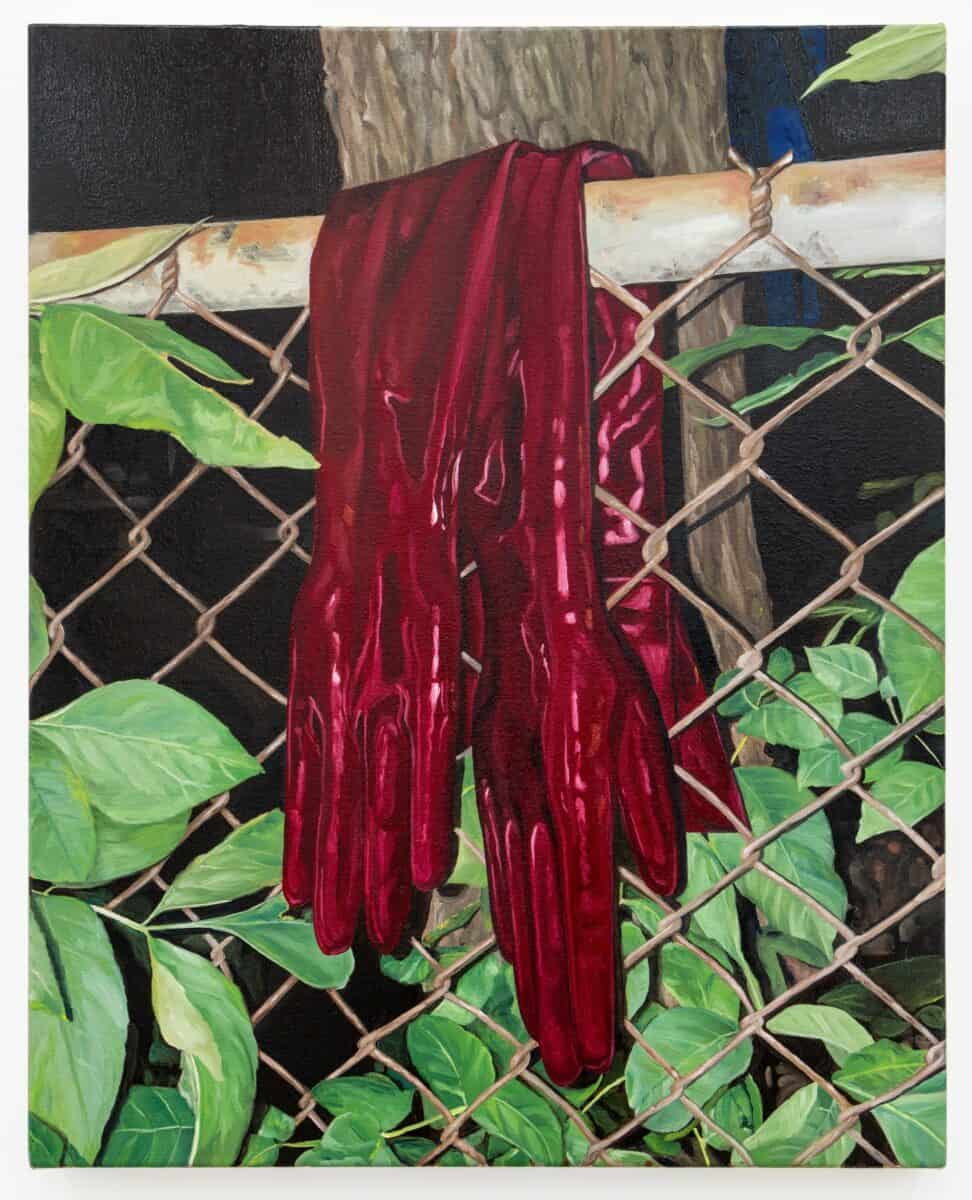
P.E.S: A duality embedded in your work is your subject matter and application of paint which creates a balance of hard and soft. This push and pull creates space for fashion and beauty, delicate and bold, as well as danger and kink. Is there a main driver you would like to impart to a viewer who is experiencing your work for the first time who might otherwise misunderstand or take it at face value?
N.T: I cannot control the way people perceive me or my paintings because that’s just delusional. I have learned this the hard way and it’s been a hard pill to swallow but I feel relieved and free now. There is a clear duality in my work because I am a person of duality; holding the tension of the opposites, integrating polarities to everything I do. I accept the conflicting aspects of my personality without succumbing to one extreme or the other, and finding that place of balance is what makes my paintings work for me. The dichotomy between that which is soft, inviting, comforting, and that which incites unease, tension, anxiety. The things that feel familiar yet slightly out of place. You could say that’s the main drive.
I do think that people tend to intellectualize things way too much and sometimes we ignore how a piece of art makes us feel because we are trying to understand the deeper meaning of what is in front of us, which is why I don’t mind being taken at face value. Whatever my paintings make people feel is not up to me and I am okay with that.
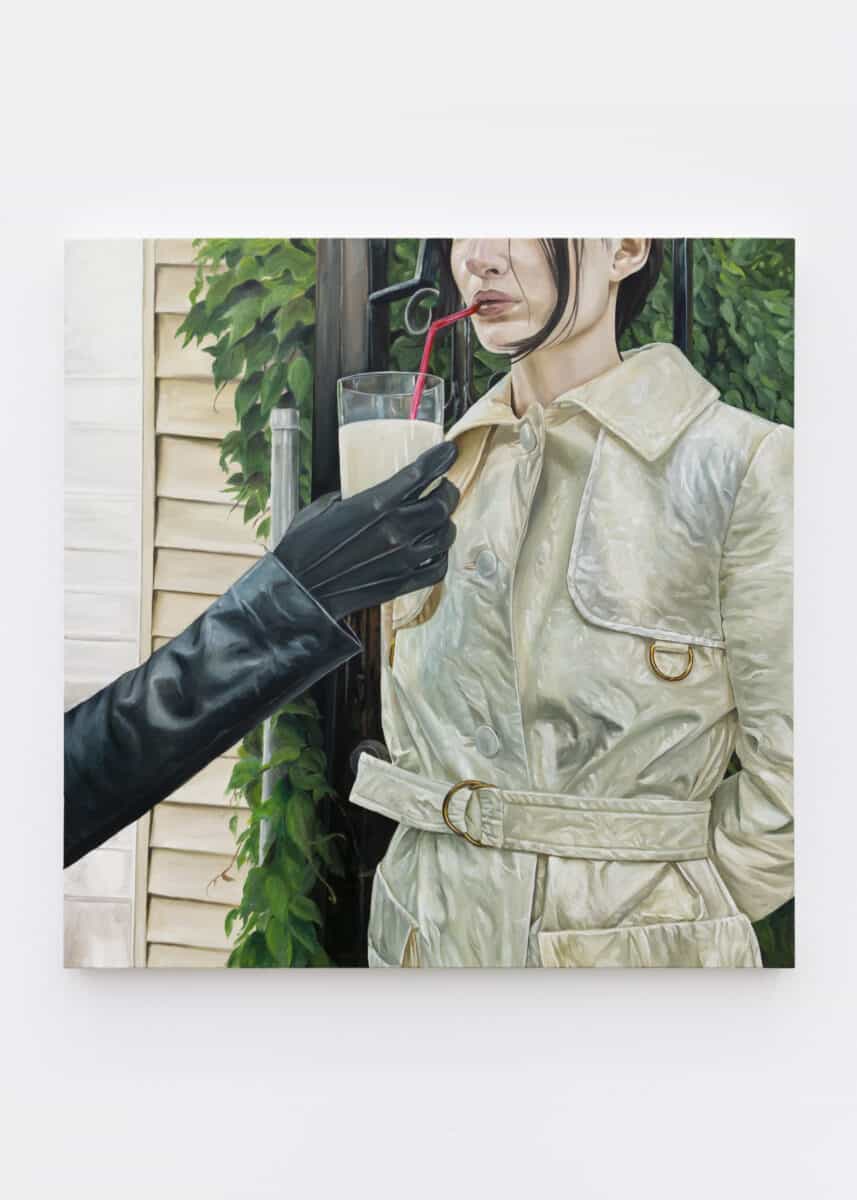
P.E.S: There is a highlighting of “subculture” by depicting forms and materials that are typically used in private and adult settings. The association you make within your work about the thin and blurred lines of pain and pleasure can be seen through some imagery you utilize like hardware, bondage, latex, and leather. How do you think these scenes affect the conversation and change the dynamic of “fine art”?
N.T: I don’t believe I am doing anything groundbreaking by using latex or leather in my paintings. I do not do it for shock value or to challenge the status quo of the art world because it’s 2023, we’ve all been on the internet for long enough to see said things become extremely normalized and commodified. There have been many artists before me who have paved the way. We had John Sutcliffe whose magazine Atomage was prosecuted, causing him to plead guilty in a trial with all of his photographs being subsequently destroyed.
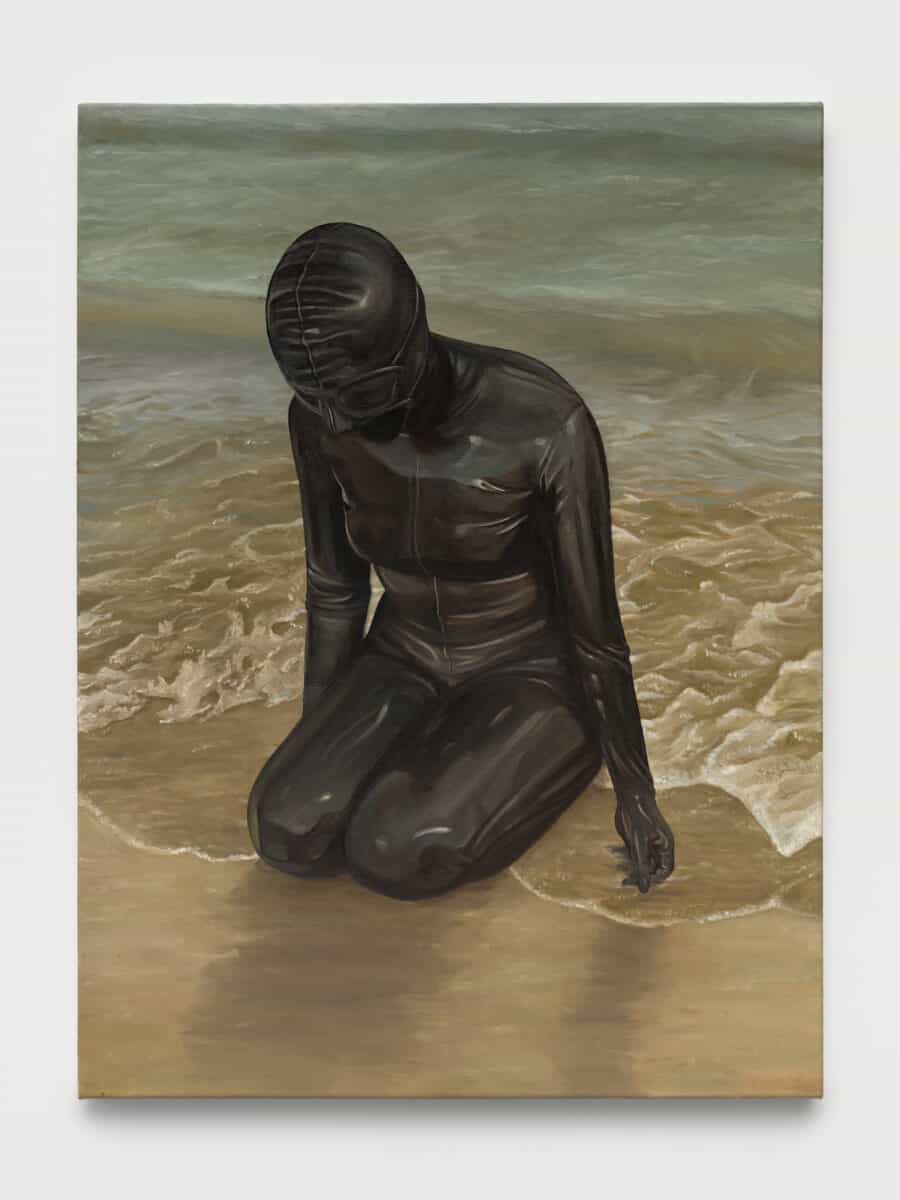
Tom of Finland was making queer kink art during times of severe oppression towards the gay community and amidst an AIDS epidemic, just like Robert Mapplethorpe. Monica Majoli and her fetish art that has been exhibited all over the world since the 90s and can be found in museums across the country, so does the work of Nancy Grossman who’s been around even longer, and the list goes on.
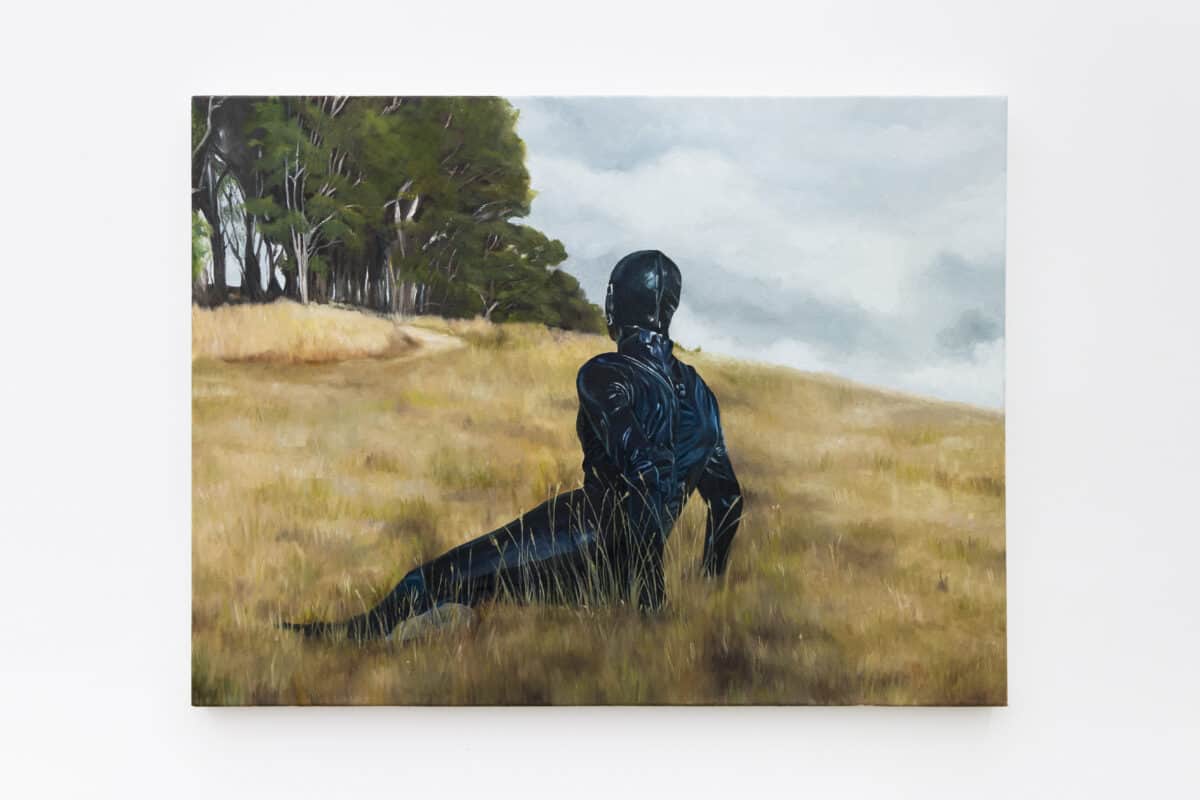
You can even see celebrities like Kim Kardashian wearing a tight latex dress or decked in head-to-toe leather with a gimp mask. It’s pretty obvious that “fetish gear” has gone mainstream. I paint what I paint because I love it regardless of how it is perceived or if it comes across as redundant and overused to some, or shocking and perverted to others. I love the textures, I enjoy incorporating elements associated with fetishism without necessarily sexualizing them because I do not think this “subculture” needs liberation. It is liberated enough, at least as of recent years, yet it isn’t often fully understood, which I think it’s a different issue, one that I can’t solve on my own. However, if my paintings challenge certain conventions and inspire viewers to question their own biases then so be it.

P.E.S: There is also a pairing of synthetic and natural within your work, flowers placed in high heels and boots substituting as a vase, metallic-looking scissors and knives positioned by long strands of hair, birds eating out of the palm of a latex glove, and lemons with nails protruding outwards, just to mention a few. What about this engagement do you find so alluring?
N.T: I think this goes back to the subject of opposites existing in harmony. It creates a juxtaposition, a tension between two realms. It’s an interplay between contrasting elements, by placing a sharp object like a knife or scissors, or even a hammer paired with other inanimate objects like flowers, lemons or a human figure speaks to themes of vulnerability, superstition, grief, pain, the fragile balance between creation and destruction, rendered in a romanticized, theatrical way that makes it look completely innocent and naive at first glance. The engagement between these elements challenge preconceived notions disrupting familiar associations, prompting the viewer to see objects and materials in a new light. By subverting traditional contexts and presenting these combinations, I invite the people to reassess their own understanding of the boundaries we impose on the objects that surround us. The allurement lies in the visual impact and the aesthetics created by these pairings.
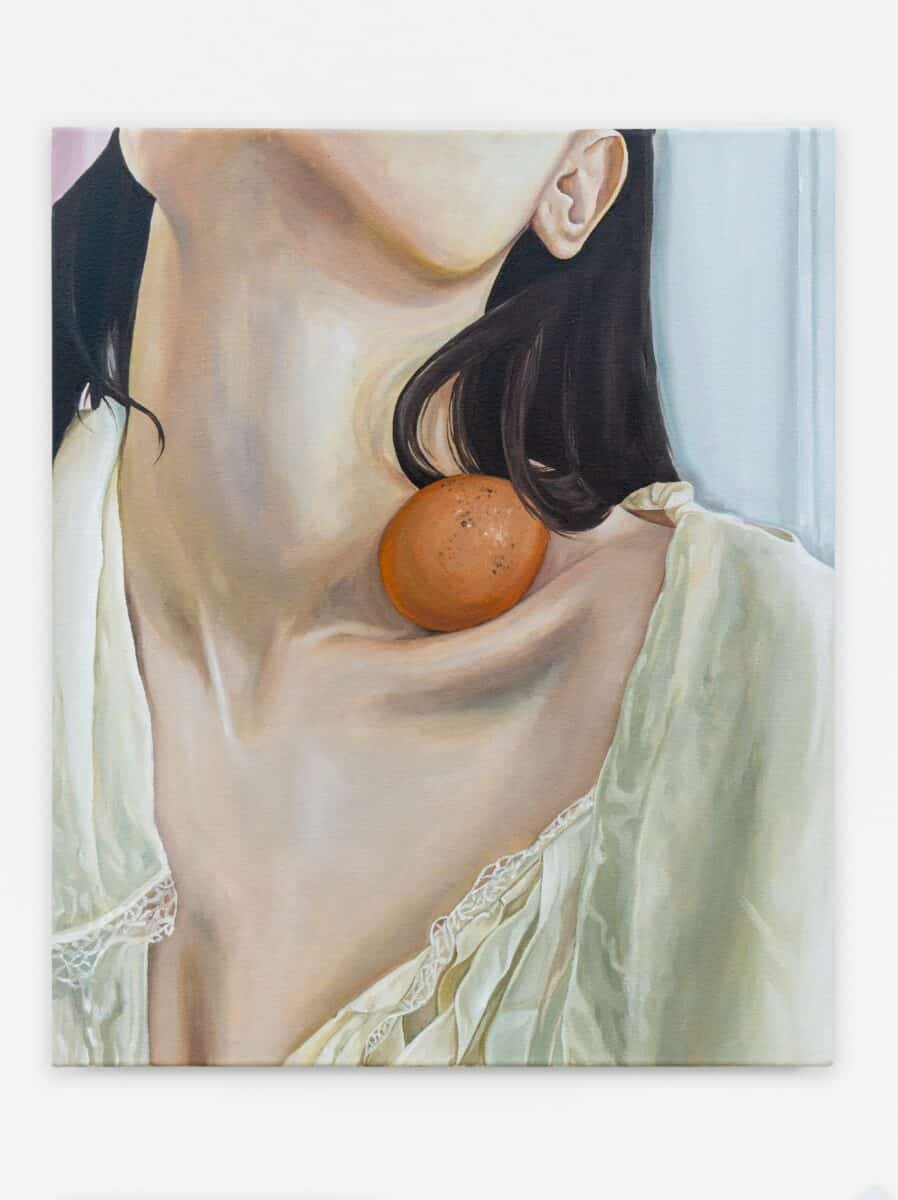
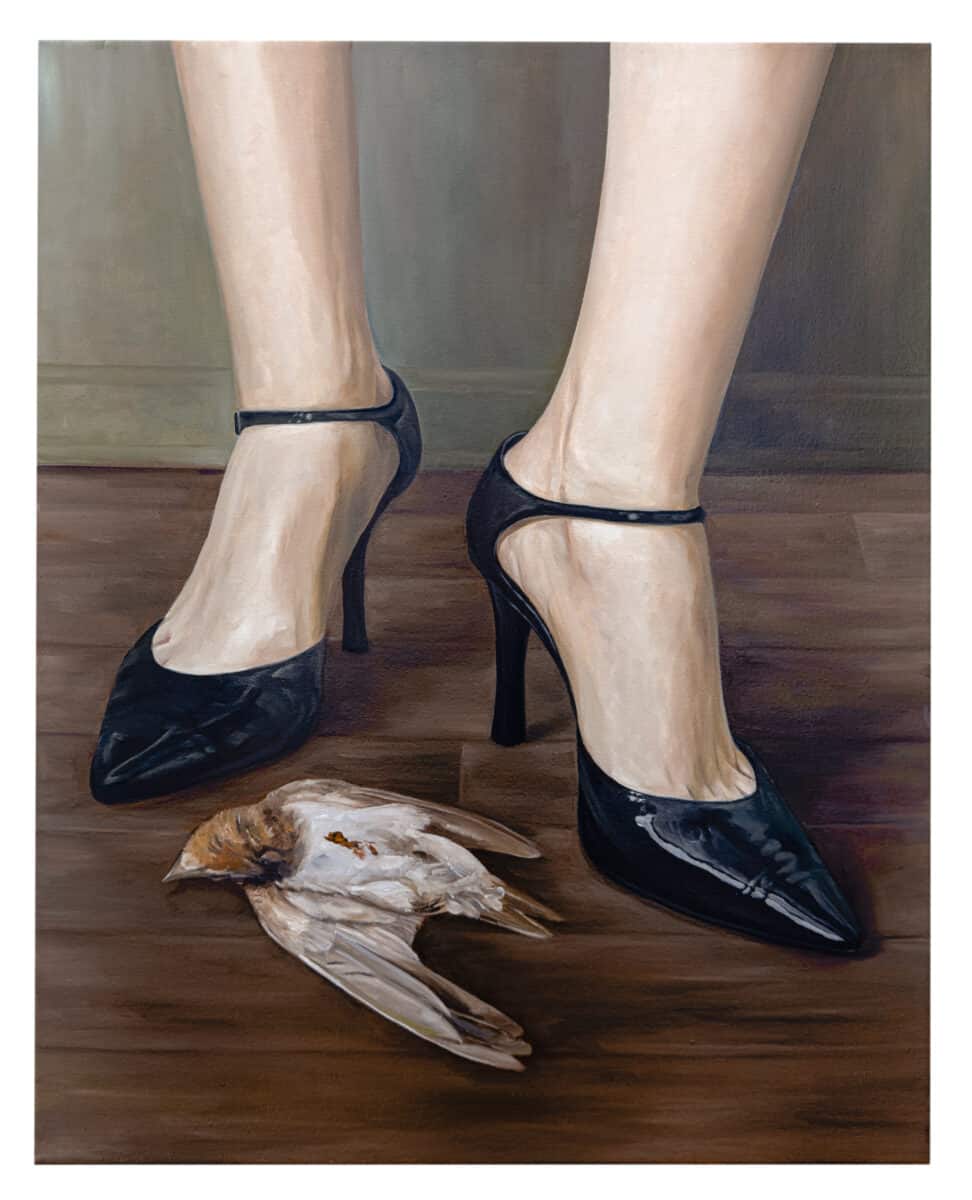
P.E.S: You have famously featured animals in your works, in a majority of their depictions they are interacting with the figures. A recent favorite of mine is Nesting and Look what the cat dragged in. What power do you typically provide the various animals you paint, are the animals symbolic representing parts of the human soul or provide a deeper allegorical meaning?
N.T: I like when elements can be symbolic without overanalyzing them. This is where semiotics enter the chat (signifier vs signified). For instance, in the case of Look what the cat dragged in you can see a dead bird on the floor. We know it’s a bird because we know what the physical form of a bird looks like, but what is the signified? We know the relationship between signifiers and signified is not universal, it can mean different things across different cultures, and even different kinds of birds have their own symbolism attached to them, yet we all have a pretty common understanding that birds are synonymous with freedom, nature, spirituality, and so on. A lot of these symbols, in particular the animals, appear to me in recurring dreams, which is something I plan on dedicating an entire series of paintings to.
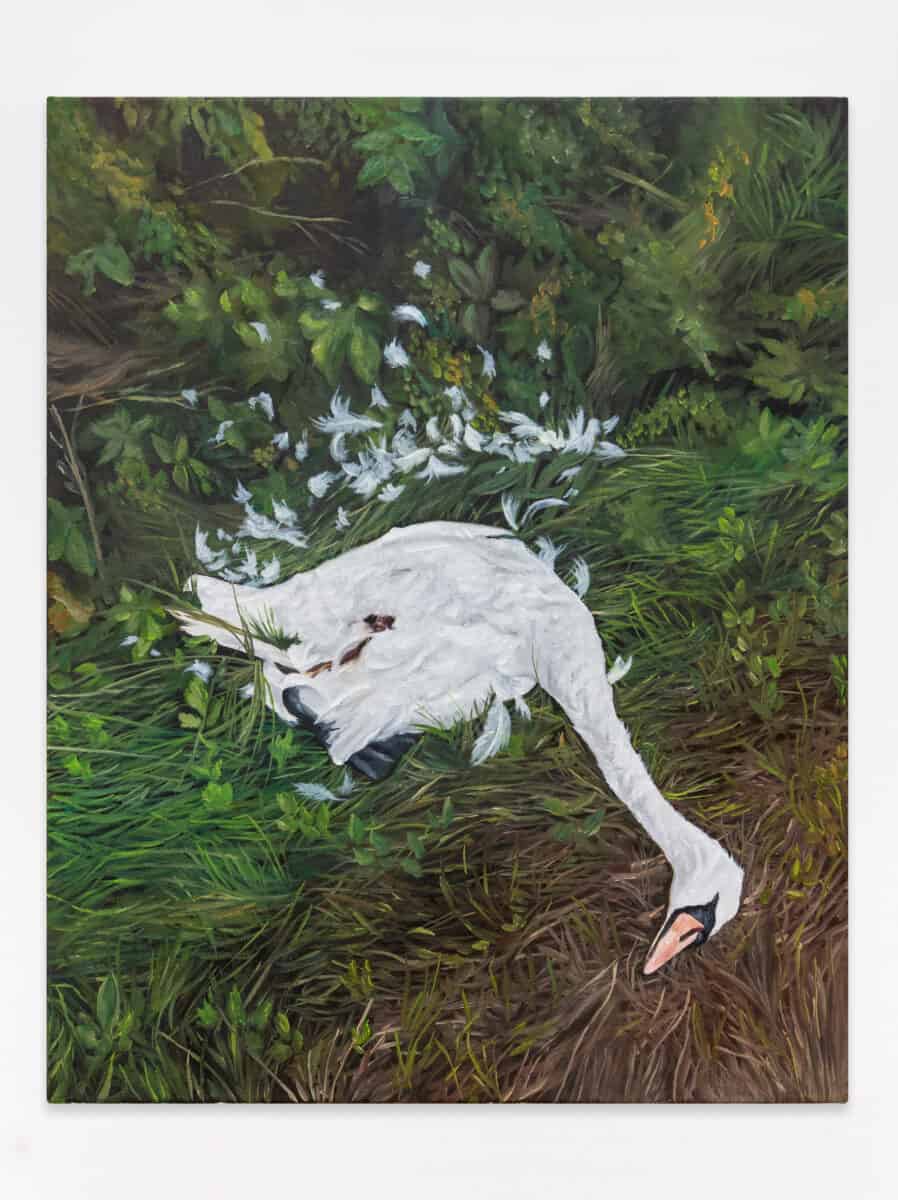
The interpretation of symbols in dreams is subjective and tied to the dreamer, yet there is a common ground where these two concepts coexist, and that’s where the magic happens. Often from using the same elements, I can get my pieces to be in conversation with one another, which is something that happens organically and isn’t intentional, that’s the case with Nesting and Look what the cat dragged in.

P.E.S: By the time a work gets to a place of public display, the gallery wall, have you already processed and moved forward from those particular ideas and feelings you were depicting or is it just another stepping stone towards understanding?
N.T: Working on the pieces for my forthcoming solo exhibition was pretty exhausting. It was difficult, not because of the labor of painting itself but because of all the things I learned during the process. It was a psychological effort. I felt relief once it was done, yet I realized there was still so much more I wanted to say, so much more to elaborate on and so much more to learn still. It felt good to put the pieces on a crate and see them go, but I will not get closure until I see them hanging from the gallery walls. It’s difficult and bittersweet. Ideas constantly leading to new ideas. I could go on forever, but not every idea needs to be materialized. This is so important, knowing when to stop, having the discipline and the courage to set a boundary, it’s hard because in my mind I am always wondering: what if…? After opening day I always seem to feel lighter and like I can finally move on, onto the next.
P.E.S: You do have a typical canvas size, but a lot of your paintings are vertical and rectangular. Why do you think you gravitate towards the security of this shape?
N.T: I do love rectangles, especially 30 x 40 inches. However, there are a lot of square shaped canvases on my upcoming show, and I recently realized this might be the result of social media’s influence on my ape brain. Instagram’s default image display of squares seems to have been subliminally infiltrating in the way I see things. I feel like we have adapted to this format so much that it automatically dictates a standard for how things should be, to the point that it’s influencing artistic decisions. “How will this look online?” I don’t think I am alone when I say I often consider how my work will appear once posted to instagram. I see it on other people’s work as well, I often find certain works could be categorized as “instagrammable”. It should come as no surprise that a platform we have used for so long for visibility and exposure has now permeated into the way we think about art. I have no choice but to embrace it, and welcome the use of squares into my work.
P.E.S: What are some of your routines and the restrictions you place on yourself in order to produce the most optimal painting?
N.T: Whenever I have deadlines I simply go full hermit mode. I don’t see my friends, I don’t play video games, I don’t even nap (well maybe I’ll take a 20 min nap instead of a full hour you have to optimize). My friends are always like wow Noelia you’re so prolific! And I’m like… yeah because I don’t have a life for extended periods of time. You have to make some sacrifices here and there but it’s usually worth it. I struggle finding a balance between work and play and I will usually neglect every other aspect of my life until I finish a task. I can’t even work on multiple pieces at once, I need to fully immerse myself into one thing, and I won’t stop or move on until it’s done.
P.E.S: What is it you want now when you think of your next phase of life and work?
N.T: I just want to pay off all of my debt and buy a house for me and my husband. I don’t like to make big plans about the future because life has proven to be so unpredictable time and time again. I want a simple life, full of love and health for me and my loved ones. I want to take care of everyone. I want to keep painting, keep doing what I do, what I am good at. I love my life the way it is and even though I am aware of the ebbs and flows, the highs and lows, I pray that the road ahead is kind.
To learn more about Noelia Towers follow on Instagram at @noeliatowers, visit her website at noeliatowers.com and visit de boer Gallery
